Introduction
This article explores five unique long-term portfolio models with valuable concepts pulled from published financial literature that have continued to outperform the S&P 500 since 2018. At the risk of revealing many years of research and enhancements, I will share some key insights about these financial models for your benefit. Some portfolio selections for 2024 will be available in the sequel to this article at the end of December – Part 2: New 2024 Selections for the V&M Long-Term Portfolios.
I hope this article provides you with three key insights to help your investing:
- Stock portfolio models offer additional advantages over individual stock picking allowing you to mitigate idiosyncratic risk through diversification.
- While stocks share some common systemic investment risks, choosing the right type of portfolio at the right time can help you outperform in changing market conditions.
- Finally, I hope you will recognize any huge gaps, as I have this year, in developing your own optimal portfolio strategy into the new year.
6 Years of Returns from Jan 2018 to Nov 2023
These five unique portfolios show different advantages with strong growth rates. I have found that five is a good mix for managing variation when it comes to timing indicators, funds to hold, or portfolio models to best leverage market returns. I trust you will see the advantages to each of these models and why I have selected them from among many hundreds of portfolios I have evaluated over the years.
VMBreakouts.com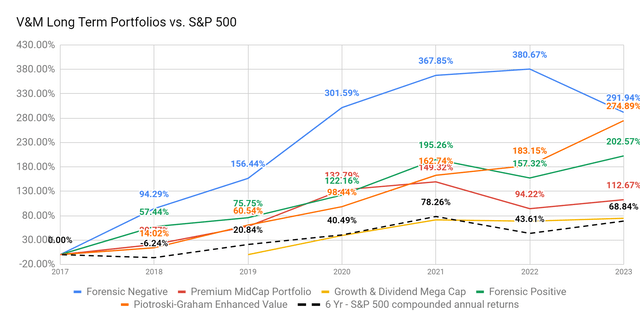
As you consider these long-term buy/hold returns for your own investing there are two additional key factors that can greatly enhance your returns even more. I will address these two very important timing factors at the end of the article:
1. Momentum Gauge signals – Why timing matters so much.
2. Macro / Systemic Market conditions – Why understanding the market environment is critical.
Let’s review the long-term portfolios I offer each January that continue to outperform the market benchmark indices. In particular, the Piotroski-Graham value portfolio shown in orange below has never trailed the S&P 500 in any of the last six years. The Forensic Negative portfolio continues with the best compounded average growth rate, but also with the strongest reactions to the macro events in the market as I will discuss later.
VMBreakouts.com
The Growth & Dividend Mega Cap portfolio began with a request in 2020 and so it is compared in the same time frame to the four-year S&P 500 compounded returns of +39.7%. However, in either case, the Growth & Dividend portfolio model +74.65% is outperforming both the four-year and six-year S&P 500 compounded annual returns.
Without further details and discussions, here are my five diverse portfolios with actual returns, free of common distortions from simulated back-testing or future extrapolations. As this article will illustrate, past returns are no guarantee of future returns and you should adjust accordingly.
1. Piotroski-Graham Enhanced Value portfolio
Let’s start with the algorithm portfolio using the value models from Joseph Piotroski and Benjamin Graham. Not only have these long-term value approaches survived decades of testing in the published financial literature, but the additional enhancements I have made show even larger returns than baseline portfolios these scholars originally published. So far, this enhanced value portfolio has beaten the S&P 500 in every year since 2018 with sizeable annual and compounding returns well above the S&P 500.
- Top Piotroski-Graham Long-Term Value Portfolio: 2022 Returns +13% With New 2023 Selections
It’s quite common for these value portfolios to be paired against growth portfolios in a relatively strong inverse relationship. A couple of examples of the top stocks in this portfolio include Honda Motor Co., Ltd. (HMC) +36.6% and SkyWest, Inc. (SKYW) +180.5%. But what I have observed from years of study is that most long-term buy/hold portfolios benefit even more strongly from adjusting to changing market momentum conditions.
stockrover.com/vmb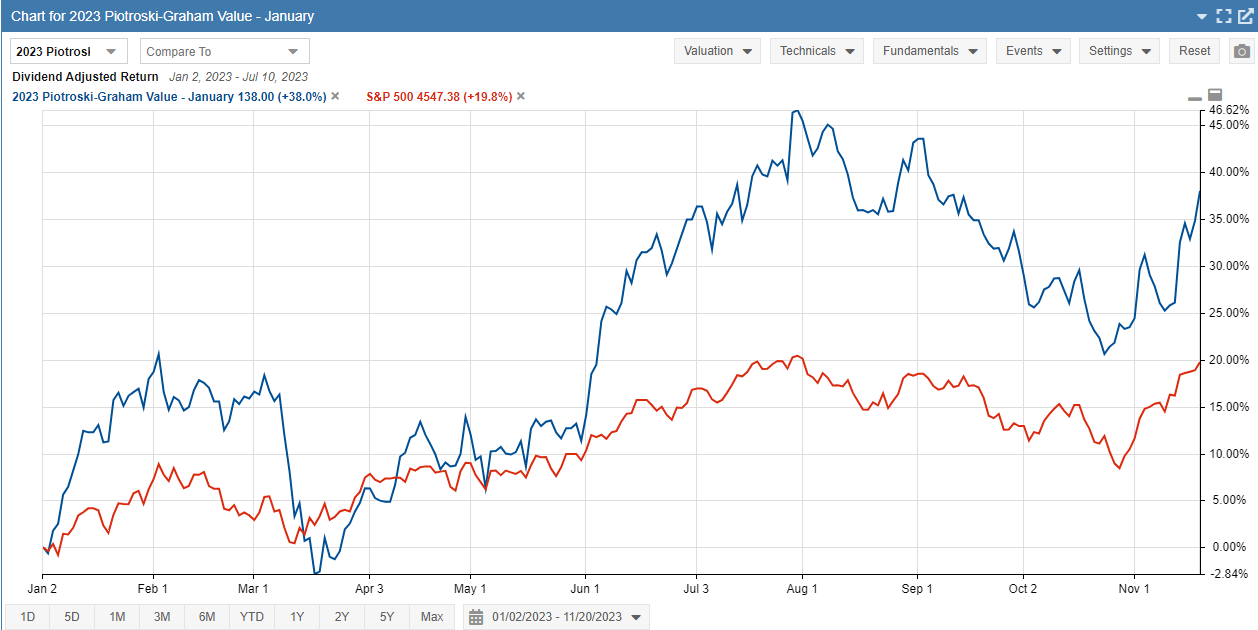
Let me explain further by using a momentum model I constructed from my doctoral research days. As you can see below using the Momentum Gauge signals, the weekly negative signals in February preceded the major downturns in March from the banking crisis earlier this year. Then positive signals in April preceded the run to the August peak. Once again negative signals in July/August preceded the longest market downturn of the year with 10 weeks of declines to the lows of October, before positive momentum began to rebound.
app.VMBreakouts.com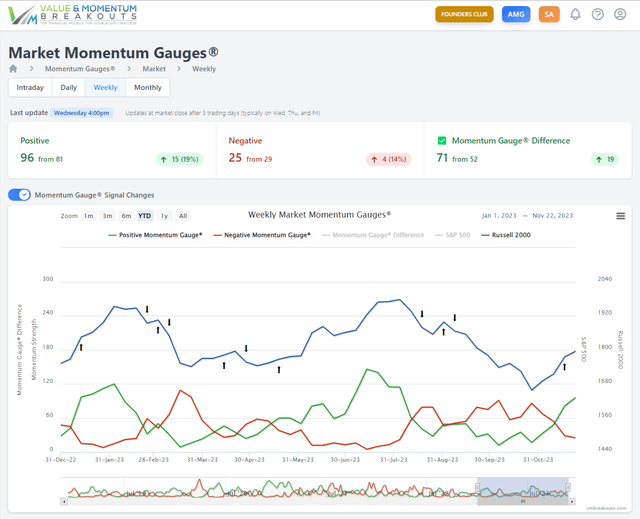
Applying the weekly or monthly momentum gauge signal may provide a smoother timing indicator with fewer signals than the daily gauges. However, the daily gauges are more sensitive to momentum changes and can provide even more time to react to potential market downturns.
2. Forensic Negative portfolio
Why would anyone include a Forensic Negative portfolio among their list of top portfolios from years of research? Doesn’t forensic relate to accounting models that test for manipulation, fraud, bankruptcy, and serious operational concerns? Yes, you can learn more about this model and why it works so well under the right conditions.
- Forensic Value Stock Selections: Highest Positive And Negative Scoring Stocks – Jan. 2023
The short answer is that time and time again, investors load up on high-risk stocks for all sorts of reasons always convinced that the risk is worth the return. Let’s take a stroll back to late January of 2021 with a look at the GameStop Corp. (GME) short squeeze event that saw over 850% returns in less than a week. Do you remember that massive short squeeze event? GameStop was a negative forensic stock selection that saw record gains not only in that short week but it continued with enormous swings up and down over 200% through July of 2021.
FinViz.com VMBreakouts.com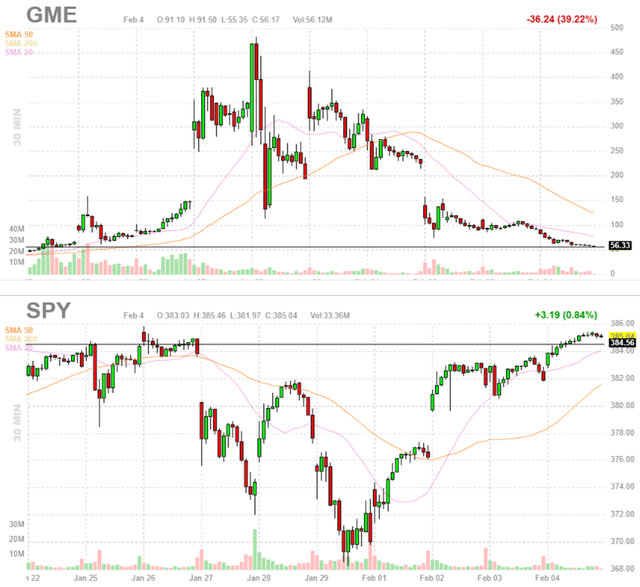
As I show above in time-linked chart with the SPDR S&P 500 ETF Trust (SPY) the inflows to the GameStop exuberance (or insanity) were so large that the S&P 500 saw over -5% declines in the same week. In other words, investors were dumping perfectly good large cap stocks just for the opportunity to load up a massive negative forensic stock opportunity. Looking back I believe some of that exuberance was a function of the Federal Reserve’s largest Quantitative Easing program in the history of the United States and the record stimulus was finding its way into every corner of the stock market.
VMBreakouts.com
So now you may have a better idea about why tracking a Negative Forensic portfolio that produced more than 300% returns in the first three years was an important addition to my collection of top long-term portfolios. However, as the Fed’s quantitative tightening replaced massive quantitative easing, I began to highlight the risks of these negative forensic stocks that the Federal Reserve essentially labeled “Zombie” firms. As time goes on you realize these cycle changes and momentum signals matter:
- Latest U.S. Zombie Firms With The Highest Potential Credit Risks, Plus 6-Month Update
So how did that look on the Forensic Negative portfolio for 2023? It started the year as shown below with major +24.3% gains in just the first couple weeks of the year. This January portfolio consisting of banks, REITs, and biotech stocks saw a major bubble burst in March as the regional bank crisis saw the largest number of bank failures since 2008.
stockrover.com/vmb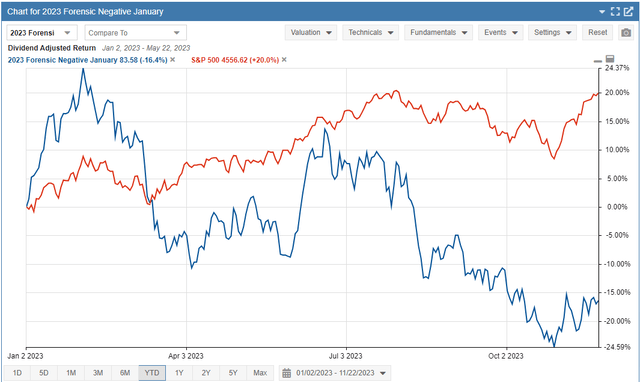
Despite some bounces along the way on the market momentum gauges in April, these stocks have shown considerable weakness as we approach the end of 2023.
app.VMBreakouts.com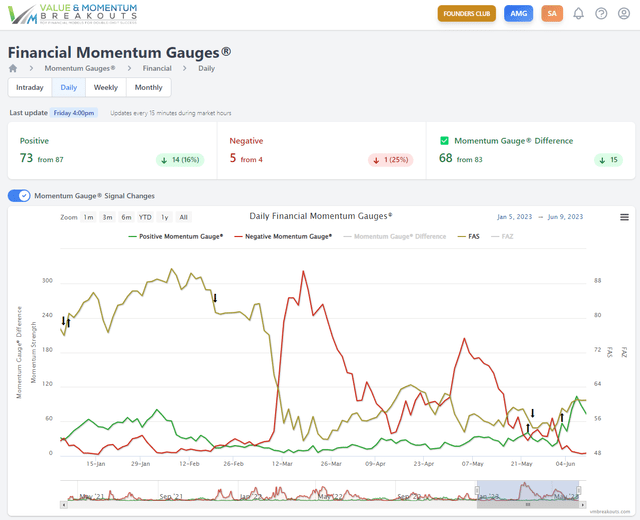
Again, you can see more clearly on the Financial Sector momentum gauges from January just how severe the decline was for the banking sector back in March. The momentum gauges detected a negative signal for the financial sector in the middle of February, weeks before Silicon Valley Bank and others suffered the worst collapse in the financial sector since 2008. A couple of well-known examples of these stocks include Virgin Galactic Holdings, Inc. (SPCE) -42.8% and bluebird bio, Inc. (BLUE) -45.2%
What can we conclude from this unique negative forensic portfolio? One thing I have seen is that when times are good, stimulus is high, and investors are eager to throw caution to the wind for a big potential payoff at the casino, this is a great model for large gains.
3. Forensic Positive Portfolio
So if the negative forensic portfolio provides high risk and high return potential, what should we expect from the positive forensic portfolio? You probably guessed, lower returns, lower risks and only approximately 3x greater compounded returns than the S&P 500. Sure the total returns are much lower for the positive portfolio than the negative portfolio over the past six years, but the lower risk factors may be worth it.
Forensic Value Stock Selections: Highest Positive And Negative Scoring Stocks – Jan. 2023
So far this year the Forensic Positive portfolio is up +20.54% nearly identical to the S&P 500 this year, but without any of the mega cap giants currently accounting for over 80% of the S&P 500 gains.
stockrover.com/vmb
The top stock in this portfolio for 2023 is Trex Company, Inc. (TREX) +59.65% YTD with strong earnings and continued positive momentum.
4. The Premium Portfolio
This actively traded portfolio follows member requests for a portfolio that only selects stocks above $1 billion market cap. It also competes for returns among thousands of mid-cap and large-cap stocks usually avoiding the top 1% market cap stocks in the extremely crowded “passive” market index funds.
VMBreakouts.com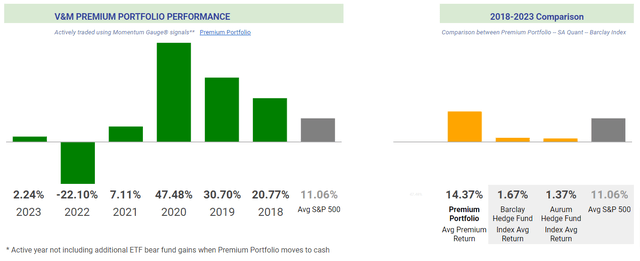
You can see in the comparisons to the Aurum and Barclay hedge fund indices how well this active portfolio has performed over the last six years relative to the leading hedge funds with high expenses and management fees.
VMBreakouts.com
Additionally the Premium Portfolio goes to cash whenever the S&P 500 large cap momentum gauge signals turn negative. This has minimized losses greatly in 2018 and 2020 and has put the Premium Portfolio in cash for as long as 25 weeks with returns that greatly exceed market and hedge fund indices. Also long-term readers know that I offer ETF models to trade in bear funds for gains (not added to the Premium portfolio) while these extended negative signals keep the portfolio in cash.
5. January Growth and Dividend Mega Cap Portfolio
Lastly, let’s look at the long-term growth and dividend portfolio with compounded returns of +74.6% from 2020 compared to +39.7% for the S&P 500 over the same period. Currently the January portfolio YTD returns through Nov 22nd are at +7.95% adjusted for the high dividend selections required of stocks in the portfolio.
stockrover.com/vmb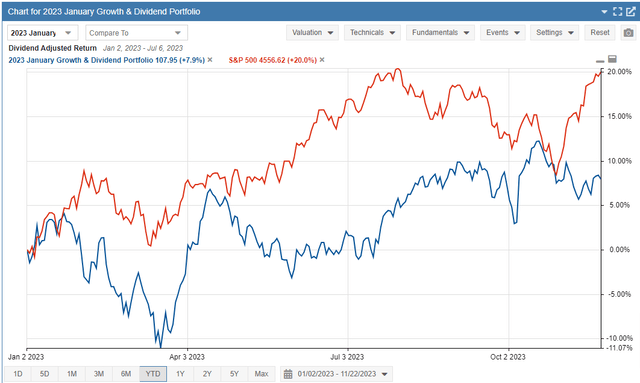
Every month since 2020 I release a new long-term dividend portfolio for our investing community. The two-year measurements of final returns and peak returns (yellow) of each monthly portfolio are charted below. What you’ll immediately notice are huge two-year returns in the 2020 portfolios followed by a sudden drop off in high dividend stock portfolio performance.
VMBreakouts.com
Did the dividend model suddenly fail to work? Did the algorithm just become bad at picking top dividend stocks? No, the macro environment for corporate dividends changed dramatically. As you can see in the BlackRock Corporate High Yield Fund, Inc (HYT) below, corporate dividends took a big hit in 2022 almost as severe as the COVID decline in 2022. Along with the decline in dividend yields investors have been moving to other investment opportunities including exiting the stock market in favor of high yielding treasuries.
FinViz.com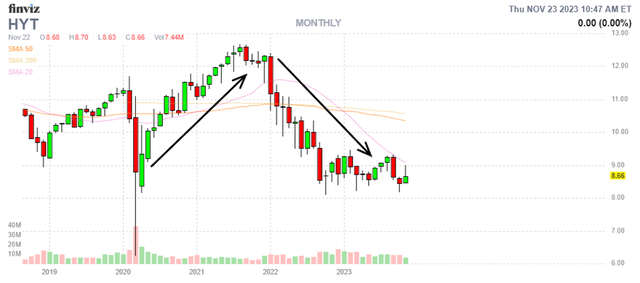
A similar pattern is evident with REITs known for high dividend yields. You can see on the ALPS Active REIT ETF (REIT) how sharply stocks in a similar asset class have fallen from the peak of 2022. Dividend investors are bailing out of high dividend equity positions and moving into other assets including cash and treasury bonds.
FinViz.com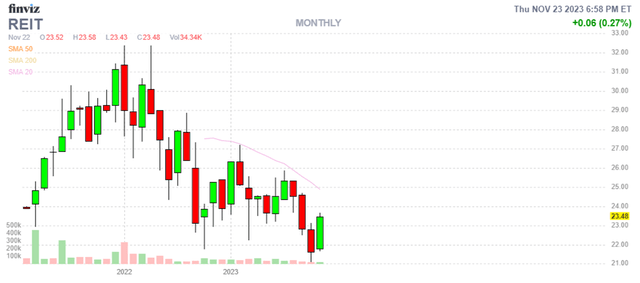
This is yet another example of how important it is to watch the macro market environment.
Macro/Systemic Market conditions matter
Macro factors from Fed Intervention, interest rate hikes to COVID corrections matter a great deal. Here we are still in the largest quantitative tightening event in US history with the highest interest rate hikes in 22 years. A review of the 2,000 stocks on the Russell index (reconstituting at every June blue square) back to 2018 shows you the incredible events we have seen in the past six years.
FinViz.com VMBreakouts.com
I have written at length about the record Fed balance sheet manipulation to sustain markets since the financial crisis of 2008.
- In what I call QT 1 (the first quantitative tightening event) back in 2018, the Fed tightened their balance sheet for the first time since the financial crisis and the market dropped sharply.
- A cut in rates and the end of balancing sheet tightening gave us all a nice 2019 rebound.
- We all remember when COVID came along and rocked markets again until March 23 when the Fed stepped in again.
- The largest Fed stimulus QE 4 from 2020 to 2021 made every stock picker look like a genius with the highest Fed stimulus in US history.
- Then the Fed halted QE 4 on March 9, 2022, and the markets dropped again on the lack of liquidity.
- 2023 has given us a lot of chop and the most concentrated buying of the seven largest stocks ever recorded in US history.
Yardeni.com
What concerns are there as Warren Buffett’s Berkshire Hathaway has moved to record high levels of cash?
A Huge Gap
So this leads me to reveal the huge glaring gap in the five long-term portfolios offered above. Despite significantly beating the S&P 500 returns since 2018, none of my long-term portfolios are likely to pick up Meta Platforms, Inc. (META), Amazon.com, Inc. (AMZN), Apple Inc. (AAPL), Microsoft Corporation (MSFT), Alphabet Inc. (GOOG) (GOOGL) or NVIDIA Corporation (NVDA). These mega cap technology giants do not offer large dividends, have not shown up yet in the positive or negative forensic algorithms, and certainly won’t make the Piotroski-Graham valuation metrics at valuations over 100x earnings.
What does this huge gap in the portfolios look like? It looks like enormous swings in the BMO REX MicroSectors FANG+ Index 3X Leveraged ETN (FNGU) of the 10 largest stocks in the stock market. While these mega caps may provide stronger resilience against record high interest rates, they can get as overvalued as any asset in the marketplace.
FinViz.com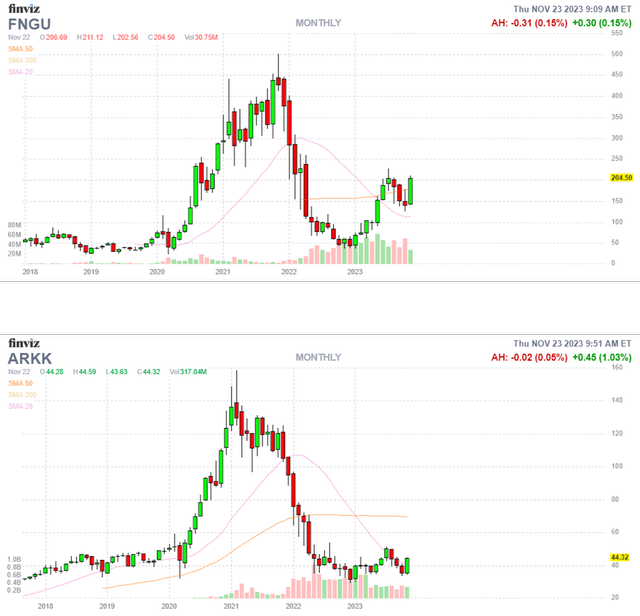
The famous ARK Innovation ETF (ARKK) frequently loads up on mega cap tech stocks. At one point the fund had over $11 billion under management and is now lagging the basic FANG+ Mega cap bull fund as it touches levels back to 2018 erasing all its gains over the past 6 years. There are few buy/hold long-term opportunities in the market, but there are ways to adjust.
Wall Street Wants You To Compare
This article is already getting longer than I intended and I will conclude with some excellent insight from Lance Roberts over at Real Investment Advice:
The financial services industry is predicated on upsetting people so that they will move money around in a frenzy. Money in motion creates fees and commissions. The creation of more and more benchmarks, products, and style boxes is nothing more than the creation of more things to compare with. The end result is investors remain in a perpetual state of outrage.
This market bifurcation may not change in 2024 if Goldman Sachs is correct in their estimates.
“Consensus expects the Magnificent 7 will continue to deliver faster growth than the rest of the index. Analyst estimates show the mega-cap tech companies growing sales at a CAGR of 11% through 2025 compared with just 3% for the rest of the S&P 500. The net margins of the Magnificent 7 are twice the margins of the rest of the index, and consensus expects this gap will persist through 2025.
Conclusion
Be careful not to chase. The table below from Callan Investments is an excellent example of the risk investors take by chasing last year’s best-performing sector. The leading asset class one year is rarely the top performer for long.
Callan Investments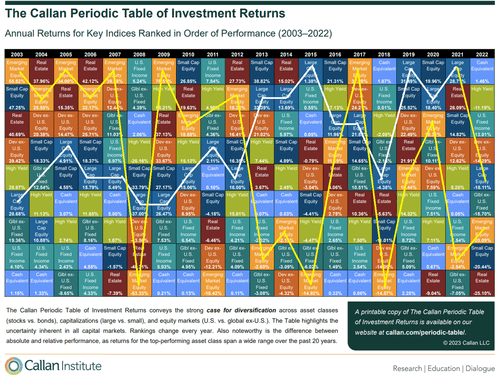
Financial Resource Corporation summed it up best;
“For those who are not satisfied with simply beating the average over any given period, consider this: If an investor can consistently achieve slightly better than average returns each year over a 10-15 year period, then cumulatively over the full period they are likely to do better than roughly 80% or more of their peers.
I would submit if you follow the momentum gauges and adjust to the changing macro environment you can get much better returns. As we see time and again, returns could easily be erased in the next year if you are not using some method to adjust your long-term investment signals and strategies. The financial industry has every incentive to keep you moving your money around. The five unique long-term portfolios I offer are an excellent starting place to design your optimal portfolio around.
In Part 2 I will release the new long-term portfolios for 2024. I hope they will serve you well in all your investing decisions!
JD
Editor’s Note: This article discusses one or more securities that do not trade on a major U.S. exchange. Please be aware of the risks associated with these stocks.
Read the full article here



